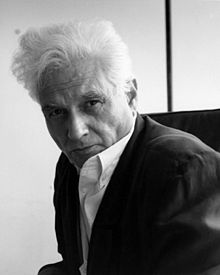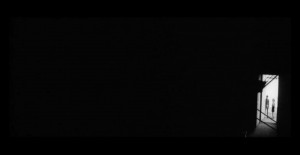Sacrificial Heterologies (Part 5)
By Asher Crispe: July 1, 2012: Category Inspirations, Thought Figures
The Binding of Kierkegaard, Heidegger, Levinas and Derrida
Logic of Derrida: Aufhebung
 Turning now to the final destabilizing of our story, Derrida picks up where Levinas left off regarding the finality of death. He modifies the notion of responsibility beyond death and instead asks after the nature of the knowledge of death or existence/non-existence beyond life. Structurally, he maintains death as a limit—a limit that is crossed or transgressed.
Turning now to the final destabilizing of our story, Derrida picks up where Levinas left off regarding the finality of death. He modifies the notion of responsibility beyond death and instead asks after the nature of the knowledge of death or existence/non-existence beyond life. Structurally, he maintains death as a limit—a limit that is crossed or transgressed.
As a point of argument Derrida contends that with all limits or borders the undercurrent of their being established as such requires one to be in some manner (projected or otherwise) on both sides at once. Seeing over the fence clarifies the fact that the fence is a fence. The assertion of any boundary necessitates pulling its hither side out of a condition of ambiguity. This conundrum retrofits the fence with its function. As Derrida remarks:
Here, now, is an interrogation: ‘Can death be reduced to some line crossing, to a departure, to a separation, to a step, and therefore to a decease?’ And, finally, here is a proposition that could be called interro-denegative: ‘Is not death [un trépas], an overstepping or a transgression (transpire, ‘sic transit,’ etc.)?’
You have noticed that all these propositions, whatever their modality, involve a certain pas [step, not]. (33)
With his everlasting love for the aporetic, Derrida frames another of his famously undecidable oscillations between apparently oppositional tendencies. Ironically this will bring us full circle back to the clutches of Hegel that Kierkegaard sought to escape from.
The binding in question consists in the uniting of opposites. When a person is sacrificed, the moment of death is taken (at least formally) to indicate the absence of the person—no one has gone beyond. The negation disqualifies the sacrifice with the loss of the person sacrificed. Unless of course, we are sustained in death in which case an individual is there to undergo death, emerging on the other side. This conservation principle in wake of negation displays the essential trademark of the Hegelian dialectic—Aufhebung. This double bind, or double gesture as Derrida refers to it, enables a condition he framed in one of his most subversive works entitled Glas:
The two sides face each other without the ability to rejoin or complete themselves, like two abstract halves or partitions of one same spiritual body….The first synthesis that permits binding [lier] them or reading [lire] them together, thinking them as the flanks of one and the same continuous piece [tenant], their first integration (Integration), is Sittlichkeit {Morality}. (34)
For Derrida, child rearing possesses this same paradoxical duality of forging not only the child but also bringing out the family. If we read the following passages from Glas in the margins of Genesis 22, might we not reassign ourselves to tasking our narrative to be an educational one? Thus, the sacrifices of a good education entail situations where: “Education is also a constituting/deconstituting process of the family, an Aufhebung by which the family accomplishes itself, raises itself in destroying itself or falling (to the tomb) as family.” (35) Additionally, for Derrida:
The father loses his son like that: in gaining him, in educating him, in raising him, in involving him in the family circle, which comes down, in the logic of Aufhebung, to helping him leave, to pushing him outside while completely retaining him. The father helps his son, takes him by the hand in order to destroy of the family in accomplishing it within what dissolves it…. (36)
Lodged in the Hebrew version of our text is another nuance which transfers into the Derridean commentary—the notion that Isaac should be a pure burnt offer—olah (עולה)— shares a etymological connection with the idea of elevation—aleyah (עליה)—or going up in general. Thus we hear Derrida broadcasting a variant of this within his French lexicon: “Rearing (the student), l’élève. What is élever in general (éléage, élevation, élèvement, breeding, elevation, education, upbring)?” (37)
Others contend that the process depicted here is not a simple educational one but rather a kind of rebirthing. (38) In this light, death as the trespassing of boundaries represents a transition similar to birth where the same questions may be addressed that obsess Heidegger and Levinas on the other end of the temporal ‘spectrum’ of Dasein.
As much as we are curious about the definitions used and the accessibility of knowledge employed on the death side of life, we can just as easily speculate regarding where we came from. Before birth was I in a world? Did I transition from somewhere else—from world to world or shift from one mode of being to another? Perhaps, I became uniquely individuated at the moment of my birth where, already irreplaceable, no one else could take my life and live it for me?
While something can be maintained, educated, or elevated with the destruction of the old, tearing down previous levels, what we are really witness to is but “…a simulacrum of sacrifice…” or maybe a “…simulacrum of castration” for “circumcision and the sacrifice of Isaac are analogous gestures.” (39)
 Restricting one’s creative output is inscribing it within protective limits (circumcision) tracing out the same abstract patterns of discipline that reform an individual through the uplifting performance of self-sacrifice. Holding oneself in check and exercising self-restraint consumes many of one’s personal possibilities whose unbridled expression would no doubt prove more plainly destructive than the voluntary surrender and sacrifice of them. Distributing the calculations of this auto-affected immobility—where one actively seeks to tie oneself down—only highlights the economics of the matter.
Restricting one’s creative output is inscribing it within protective limits (circumcision) tracing out the same abstract patterns of discipline that reform an individual through the uplifting performance of self-sacrifice. Holding oneself in check and exercising self-restraint consumes many of one’s personal possibilities whose unbridled expression would no doubt prove more plainly destructive than the voluntary surrender and sacrifice of them. Distributing the calculations of this auto-affected immobility—where one actively seeks to tie oneself down—only highlights the economics of the matter.
Derrida, like Levinas contests the judgment of those who insist that a real sacrifice will take place opting instead for a contingency: “Here we are not concerned with a real event but with an economic simulacrum: the property is constituted by castration’s le vraiment feint, its truly feigned (circumcision and the interrupted sacrifice of Issac).” (40) Why plead for an Isaac lost and forgotten when the underlying intention is that “the sacrifice, the offer, or the gift do not destroy the all-burning that destroys itself in them; they make it reach the for-(it)self, they monumentalize it.” (41)
The monument outlasts the event just as Isaac outlives his own death. The real terminus befalls the sacrifice itself: first with its interruption (the second address of God returning us to the ethical order) and then with the substitution of the animal as the ‘animal within us’—the nature tendencies of our behavior that need to be elevated through proper education. As new modes of behavior outstrip old ones, they ascend with the fuel of expired youthful states consuming them while energizing the process of change. The Derridean application of Aufhebung signals the miracle of self-transformation casting this ‘positive’ entropy (or anti-entropy) in a new light:
It sacrifices itself, but only to remain, to insure its guarding, to bind itself to itself, strictly, to become itself, for-(it)self, (close)-by-it(self). In order to sacrifice itself, it burns itself. The burning then burns itself and goes out; the fire appeases itself….The sacrifice belongs, as its negative, to the logic of the all-burning, one could say to the double register of its accounting, accountable calculus. (42)
In this new twisted logic, Derrida contends that “the contraction, the economic restriction forms the annulus of the selfsame, of the self-return, of reappropriation. The economy restricts itself; the sacrifice sacrifices itself.” (43)
33 Aporias. P.6.
34 Glas. P.11.
35 Ibid. p.13.
36 Ibid. p.13-14.
37 Ibid. p.15.
38 “This accidental closeness between akerah and akedah—“barrenness” and “binding”—reveals what is at stake in Genesis 22, as if by a slip of a letter or the tongue.” “Sacrifice is “birth done better” when birth cannot happen; binding is necessary because the body of the mother does not work.” Yvonne Sherwood from here essay “Passion-Binding—Passion” in Toward a Theology of Eros: Transfiguring Passion at the Limits of Discipline. P.182.
39 Glas. P42
40 Ibid. P.43.
41 Ibid. P.240.
42 Ibid. p.241.
43 Ibid. p.244.
http://www.interinclusion.org/inspirations/sacrificial-heterologies-part-6/


















;)
;)
;)
;)
;)
;)
;)
;)
;)
;)
